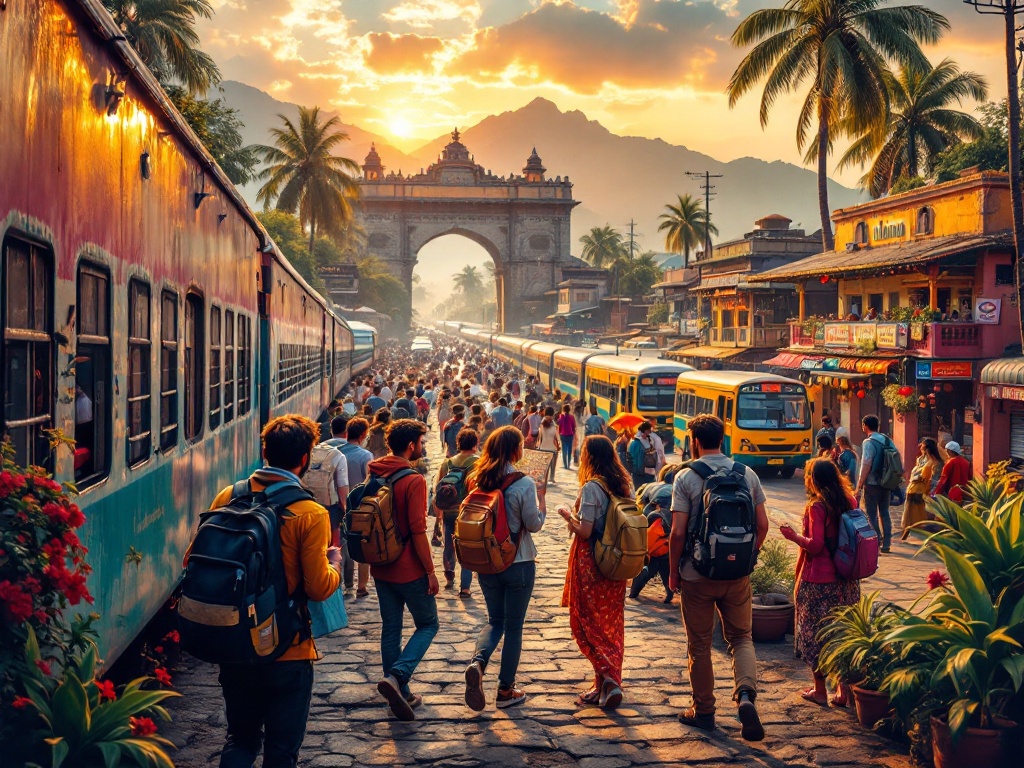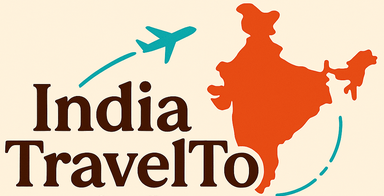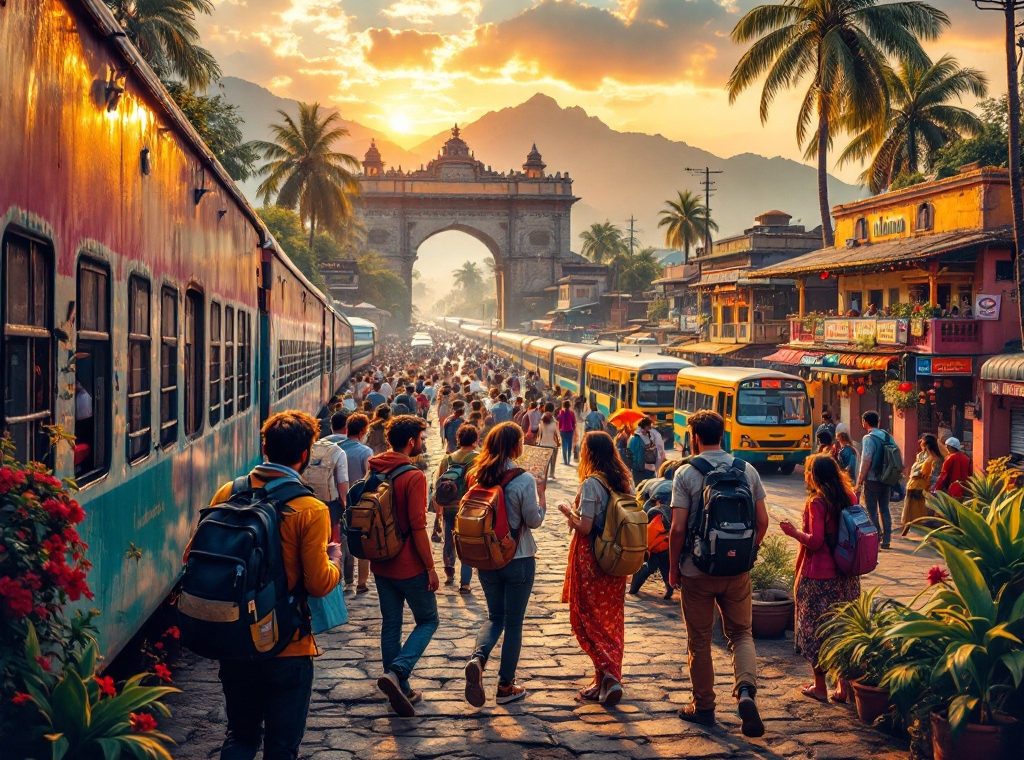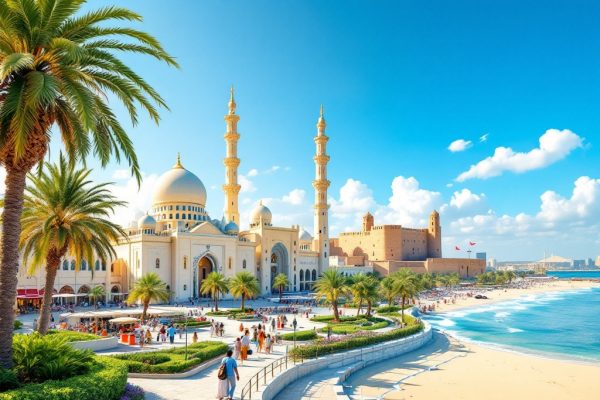How to Travel to India on a Budget: Affordable Transport and Accommodation
Dream of exploring India without breaking the bank? Discover how to experience India’s rich culture and stunning landscapes on a budget. Learn about affordable transportation, from sleeper trains to local buses, and find the perfect accommodation, whether it’s a vibrant hostel or a cozy homestay. Unlock the secrets to maximizing your rupees with smart travel strategies, including off-season travel and group discounts. Start planning your incredible Indian adventure today!
Important information

- Traveling during the off-season (June to September) offers lower prices on flights and accommodations and fewer crowds.
- Utilize public transport like trains and buses, which are significantly cheaper than taxis. Sleeper trains can save on accommodation costs.
- Embrace local experiences such as street food, less-visited areas, and free activities like visiting temples and festivals to reduce costs.
- Consider group travel to share expenses on accommodation, transport, food, and activities.
- Negotiate prices, especially in markets and with local transport providers. Book accommodations and transport in advance, especially during peak season.
Traveling to India on a Budget: An Overview
India offers incredible budget-friendly travel adventures. With careful planning, you can prioritize enriching experiences without emptying your wallet.
Embrace Local Experiences
Venture beyond typical tourist trails to discover authentic culture and lower prices in less-visited areas. Embrace local transportation, budget accommodations, and the vibrant flavors of street food to drastically reduce costs. Negotiate prices, especially in markets, and even with local transport providers.
Carry a refillable water bottle to stay hydrated and save on bottled water expenses.
Smart Travel Strategies
Maximize your savings by seeking discounts on attractions and negotiating prices while shopping. Bargaining is a common practice. Travel during the off-season (June to September) for thinner crowds and lower prices. Consider overnight trains to save on accommodation and book tickets in advance for better fares.
Free and Low-Cost Adventures
Explore the many free or low-cost attractions and activities available. India is rich with free experiences: trek through breathtaking landscapes, visit ancient temples, and immerse yourself in vibrant cultural festivals. Explore historical sites, many of which offer free entry on specific days. For a truly immersive and cost-free travel experience, consider volunteering.
Group Travel Benefits
Traveling with a group can significantly cut costs. Share expenses on accommodation, transport, and even food and activities. Many attractions also offer group discounts.
Plan your itinerary strategically to avoid unnecessary travel. Utilize public transport over taxis.
Savor delicious and affordable street food for an authentic culinary experience. This is a great way to experience local flavors without breaking the bank.
Seek out free activities. Many temples, historical sites, and cultural festivals offer free entry or participation.
Planning Your Travel Budget and Itinerary
Planning a budget-friendly trip to India requires careful planning. Start by mapping out your itinerary and setting a realistic budget, focusing on accommodation, food, and transportation. Hotels and hostels typically range from INR 750-1,500 per night. Meals are remarkably cheap, averaging around $1.50. Public transport, such as buses and trains, is the most economical way to travel between cities. Booking in advance, especially during peak season, can help you secure better deals.
Stretching Your Rupees
To make your money go further, consider venturing off the beaten path. Less-visited destinations often offer more affordable options. Prioritize your must-see experiences and allocate your funds accordingly to maximize your budget’s impact. Don’t hesitate to haggle, especially in markets, to secure the best prices.
Off-Season Advantages
Traveling during the off-season (June to September) has several advantages. You’ll find lower prices and fewer tourists. Overnight trains can save on accommodation costs. Eating at local eateries provides authentic, budget-friendly meals.
Creating a Budget-Friendly Travel Itinerary
Plan your trip by creating a basic itinerary outlining your destinations and desired activities. Research various transportation options, including sleeper trains, buses, and the metro, comparing prices to find the most cost-effective choice. Explore different accommodation options such as hostels, guesthouses, and homestays, keeping your budget in mind.
Transportation
- Sleeper trains, offering overnight travel and saving on accommodation costs.
- Buses, a generally affordable way to travel between cities and towns.
- Metro systems, efficient and cost-effective for navigating within larger cities.
Accommodation
- Hostels, providing budget-friendly shared or private rooms.
- Guesthouses, offering a more local and personal experience.
- Homestays, allowing immersion in the local culture.
Consider food expenses by researching local eateries and street food stalls for affordable meals. Allocate a budget for activities and attractions, but also explore free or low-cost options like walking tours, free museum days, or exploring local markets. Remember to incorporate flexibility into your plan. This allows you to adjust to unexpected situations and embrace spontaneous adventures that may arise during your travels.
Understanding Monument Entry Fees and Discounts
Research monument ticket prices online and look for potential discounts before your trip. Visiting during the off-season often offers better rates. Advance planning can save you money.
Managing Emergency Cash and Travel Insurance
For city travel, it’s wise to carry both cash and cards, as ATMs are readily available. Crucially, obtain travel insurance to safeguard your finances against unexpected medical emergencies, lost luggage, or trip cancellations.
Affordable Transport Options in India
Traveling affordably throughout India is easy with its diverse public transport options. For long distances, Indian Railways offers subsidized tickets, making cross-country journeys surprisingly cheap. Sleeper-class trains are especially economical, allowing you to travel overnight and save on accommodation.
If trains aren’t feasible, state-run buses provide affordable access to areas often inaccessible by rail. Within cities, local buses, metro services, and shared auto-rickshaws offer convenient and significantly cheaper alternatives to taxis or private cars.
Ride-sharing apps can also help you save, but remember to negotiate auto-rickshaw fares to avoid overcharging. For intercity travel, booking train and bus tickets in advance often secures lower prices. In some remote areas, friendly locals even offer rides to hitchhikers. For longer distances, budget airlines are a viable option.
Consider Indian Railways for long journeys. Their subsidized tickets offer affordable cross-country travel. Sleeper-class options provide further savings by eliminating hotel costs.
Utilize state-run buses for areas not serviced by trains. These buses offer a cost-effective way to reach more remote destinations.
Take advantage of local transport within cities. Local buses, metro services, and shared auto-rickshaws are significantly cheaper than taxis or private cars.
Use ride-sharing apps and negotiate auto-rickshaw fares. This will help you avoid being overcharged.
Book train and bus tickets in advance for better prices. Advanced booking often secures lower fares, especially for intercity travel.
Comparing prices and booking ahead are key to maximizing your travel budget. With a little planning, experiencing India’s wonders without overspending on transport is entirely possible.
Using Indian Railways: Sleeper Trains and Booking Tips
For budget-friendly overnight journeys across India, sleeper class is a great option. Reserving your tickets in advance, especially during holidays and peak seasons, secures your spot and can even save you money.
Local Transport: Buses, Metro Services, and Shared Autos
For budget-conscious travelers, local buses offer the most affordable option. Metro systems and ride-sharing services also provide cost-effective transportation.
Public Transportation vs. Private Cars: Cost Benefits
Traveling by public transport offers significant cost savings. By eliminating expenses like fuel, parking, and tolls, you’ll have extra money to spend on enjoyable activities, such as dining out or discovering new destinations. Public transport also enhances convenience, allowing you to relax and avoid the stress of driving in traffic.
Saving with Domestic Flights and Booking in Advance
Plan your trip to India with our guide to ensure a smooth and cost-effective travel experience. Booking domestic flights in advance helps secure lower fares, especially during popular travel seasons. This also guarantees your preferred flight schedule, whether you need an early morning departure or a late evening arrival. For even better savings, consider budget-friendly airlines and use flight comparison websites to find the best deals.
Budget Accommodation in India
India offers a variety of budget-friendly accommodation options, including hostels, guesthouses, and homestays. Hostels provide both dorm and private rooms, making them suitable for solo travelers and groups. Guesthouses offer basic amenities at reasonable rates, providing a comfortable and affordable stay. For a truly immersive cultural experience, consider a homestay with a local family. This allows you to experience Indian culture and hospitality firsthand.For free lodging, try Couchsurfing. This platform connects travelers with locals who offer complimentary accommodations. It’s a great way to experience local culture and make new friends. Clear communication and respect for your host’s home and rules are essential for a positive experience.
Tips for Finding Affordable Accommodation
- travel during the off-season for lower prices,
- book ahead, especially during peak seasons,
- look for off-season discounts offered by guesthouses.
Benefits of Different Accommodation Types
Hostels: dorm and private rooms, ideal for solo travelers and groups.
Guesthouses: basic amenities at reasonable rates.
Homestays: immersive cultural experience with local families.
Exploring Hostels, Guesthouses, and Homestays
India offers a variety of budget-friendly accommodations for travelers.
Hostels
Hostels are perfect for travelers on a tight budget, offering both dorm rooms and private rooms.
Guesthouses
Guesthouses, often family-run, provide a unique opportunity to experience local life.
Homestays
For a truly immersive cultural experience, choose a homestay and live with an Indian family.
Booking
These accommodations are easily found on online travel platforms. Booking in advance, especially during peak season, is recommended to secure the best deals.
Couchsurfing: A Free Accommodation Alternative
Couchsurfing connects travelers with locals who open their homes for free, providing a budget-friendly way to experience a new culture. It’s a unique alternative to traditional accommodations like hostels or guesthouses, fostering connections between travelers and hosts through its online platform.
Booking Tips for Off-Season Discounts
Grab a hotel bargain by traveling during the off-season, where you can often negotiate lower rates.
Budget-conscious travelers can cut costs by opting for hostels, guesthouses, or homestays.
Travel Tips for Visiting India
Travel to India on a Budget
discover India without breaking the bank. traveling during the off-season (April to September) offers incredible deals on flights and accommodations. despite the warmer weather, you’ll find significant savings, making it a budget-friendly time to visit.
Share Costs with Group Travel
consider traveling with friends or family to share expenses. by splitting costs like lodging, transportation, and even meals, you’ll significantly reduce individual expenses. this transforms your Indian adventure into a surprisingly affordable experience.
Best Time to Visit: Traveling During the Off-Season
Best Time to Visit India
For budget travelers, India’s off-season (June to September) offers great value. Hotel and activity costs are lower, and fewer crowds make popular attractions more enjoyable.
October and November, post-monsoon, are also appealing with pleasant weather and lower prices.
Peak and Low Season
Winter (December to February) is peak season, offering ideal weather but with higher prices and more tourists.
The intense summer heat, from March to June, is a factor, especially in Delhi and Rajasthan.
The best time to visit India depends on your priorities and tolerance for crowds and heat.
Traveling with a Group for Cost Sharing
Traveling to India as a group offers several financial advantages. Sharing accommodations, like hotel rooms or vacation rentals, significantly lowers lodging costs per person. Group transportation, such as taxis, car rentals, and domestic flights, becomes more economical when the expenses are shared. Many tourist attractions provide group discounts, reducing the overall cost of sightseeing. Sharing meal and activity expenses also contributes to a more budget-friendly trip.













